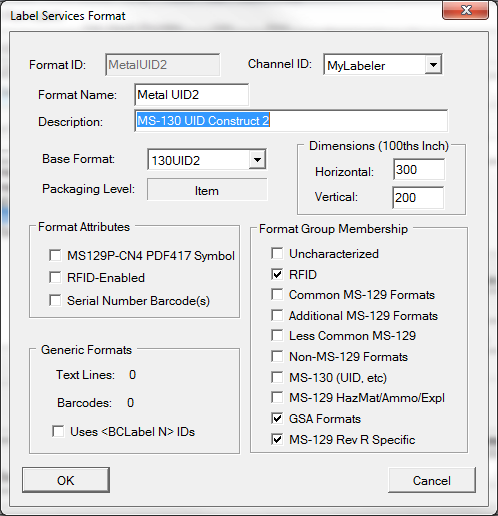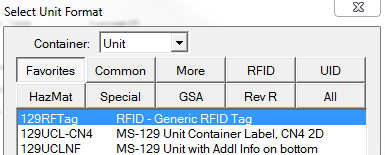Label Services formats are designed to operate just like those included in Labeling. To make this happen the definition of a Label Services format includes the same aspects that define intrinsic formats. This allows them to be easily located by the user and printed properly by Labeling.
•Format ID - the internal identifier of the format, assigned when format is created.
•Channel ID - the method by which the data is delivered to the external printer or label design software, defined by Label Services Channels.
•Format Name - a more readable version of the Format ID, which has length and content restrictions; it must be 5 - 20 characters.
•Description - a full description of the format, between 5 and 50 characters; it should be completed after selecting the base format (a bug overwrites it)
•Base Format - is the intrinsic format that this Label Service format is most closely mimicking; when printing MIL-Comply will pretend it is printing to the Base Format.
•Dimensions - of the label stock in 100ths of an inch; i.e. a 3-1/2 inch label dimension would be expressed as 350.
▪Horizontal - the width of the label.
▪Vertical - the length of the label; the same direction of movement of the label during printing.
•Packaging Level - the container nesting level that the label is intended for, as determined by the Base Format (Item, Unit, Intermediate, Exterior, Pallet, Address).
•Format Attributes - specific aspects of the label that determine the extent of the data provided.
▪MS129P-CN4 PDF417 Symbol - indicates that format requires the data string for the 2D symbol (introduced in Mil-Std-129 Rev P, Change Notice 4).
▪RFID-Enabled - indicates that an RFID tag should be provisioned at the Packaging Level, provided in the data stream, and stored in the MIL-Comply database, using the current CLIN, quantity and associated UID data.
▪Serial Number Barcode(s) - format requires serial number barcode data, at the number defined for the Base Format.
•
Generic Formats - describes the attributes of generic formats, as defined by the Base Format.
▪Text Lines - the number of lines of text sent to the format.
▪Barcodes - the number of barcode data fields sent to the format.
▪Uses <BCLabel N> IDs - enables sending captions for each barcode, in the form BCLabel1 .. BCLabel5.
•Format Group Membership - determines which format groups the format should appear in; as determined by the Base Format, but may be overridden.

